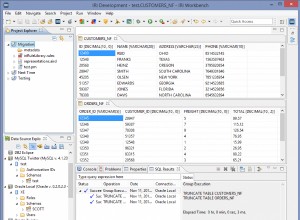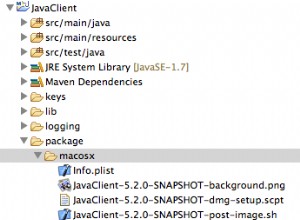Il entity-attribute-value il modello che suggerisci potrebbe adattarsi a questo scenario.
Per quanto riguarda la query di filtraggio, devi capire che con il modello EAV sacrificherai molta potenza di query, quindi questo può diventare piuttosto complicato. Tuttavia, questo è un modo per affrontare il tuo problema:
SELECT stuff.id
FROM stuff
JOIN (SELECT COUNT(*) matches
FROM table
WHERE (`key` = X1 AND `value` = V1) OR
(`key` = X2 AND `value` = V2)
GROUP BY id
) sub_t ON (sub_t.matches = 2 AND sub_t.id = stuff.id)
GROUP BY stuff.id;
Una caratteristica poco elegante di questo approccio è che devi specificare il numero di coppie attributo/valore che prevedi corrispondano in sub_t.matches = 2 . Se avessimo tre condizioni avremmo dovuto specificare sub_t.matches = 3 , e così via.
Costruiamo un test case:
CREATE TABLE stuff (`id` varchar(20), `key` varchar(20), `value` varchar(20));
INSERT INTO stuff VALUES ('apple', 'color', 'red');
INSERT INTO stuff VALUES ('mango', 'color', 'yellow');
INSERT INTO stuff VALUES ('banana', 'color', 'yellow');
INSERT INTO stuff VALUES ('apple', 'taste', 'sweet');
INSERT INTO stuff VALUES ('mango', 'taste', 'sweet');
INSERT INTO stuff VALUES ('banana', 'taste', 'bitter-sweet');
INSERT INTO stuff VALUES ('apple', 'origin', 'US');
INSERT INTO stuff VALUES ('mango', 'origin', 'MEXICO');
INSERT INTO stuff VALUES ('banana', 'origin', 'US');
Domanda:
SELECT stuff.id
FROM stuff
JOIN (SELECT COUNT(*) matches, id
FROM stuff
WHERE (`key` = 'color' AND `value` = 'yellow') OR
(`key` = 'taste' AND `value` = 'sweet')
GROUP BY id
) sub_t ON (sub_t.matches = 2 AND sub_t.id = stuff.id)
GROUP BY stuff.id;
Risultato:
+-------+
| id |
+-------+
| mango |
+-------+
1 row in set (0.02 sec)
Ora inseriamo un altro frutto con color=yellow e taste=sweet :
INSERT INTO stuff VALUES ('pear', 'color', 'yellow');
INSERT INTO stuff VALUES ('pear', 'taste', 'sweet');
INSERT INTO stuff VALUES ('pear', 'origin', 'somewhere');
La stessa query restituirebbe:
+-------+
| id |
+-------+
| mango |
| pear |
+-------+
2 rows in set (0.00 sec)
Se vogliamo limitare questo risultato alle entità con origin=MEXICO , dovremmo aggiungere un altro OR condizione e controlla sub_t.matches = 3 invece di 2 .
SELECT stuff.id
FROM stuff
JOIN (SELECT COUNT(*) matches, id
FROM stuff
WHERE (`key` = 'color' AND `value` = 'yellow') OR
(`key` = 'taste' AND `value` = 'sweet') OR
(`key` = 'origin' AND `value` = 'MEXICO')
GROUP BY id
) sub_t ON (sub_t.matches = 3 AND sub_t.id = stuff.id)
GROUP BY stuff.id;
Risultato:
+-------+
| id |
+-------+
| mango |
+-------+
1 row in set (0.00 sec)
Come in ogni approccio, ci sono alcuni vantaggi e svantaggi quando si utilizza il modello EAV. Assicurati di effettuare ricerche approfondite sull'argomento nel contesto della tua applicazione. Potresti anche prendere in considerazione un database relazionale alternativo, come Cassandra , CouchDB , MongoDB , Voldemort , HBase , SimpleDB o altri negozi di valori-chiave.




